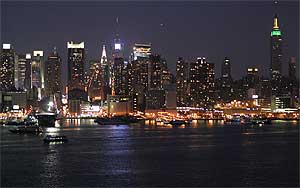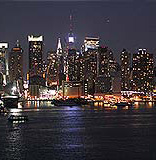When I lived in New York City, I heard a lot about Texas pride, but now that I'm in Houston, I keep wondering: Where is the pride in the Houston art scene? When I tell local artists that I've just moved from New York, they express their sympathies. Many of them say they're hoping to move to New York themselves, and some say they can't believe I would move to Houston on purpose.
When I lived in New York City, I heard a lot about Texas pride, but now that I'm in Houston, I keep wondering: Where is the pride in the Houston art scene? When I tell local artists that I've just moved from New York, they express their sympathies. Many of them say they're hoping to move to New York themselves, and some say they can't believe I would move to Houston on purpose. It's true that Houston's reputation as a cultural center is less stellar than New York's, and its art scene is less established. But not everyone should be so anxious to leave Houston for the East Coast. In fact, a number of artists and art professionals are beginning to migrate in the opposite direction, from New York to Houston, which they see as an up-and-coming city with resources not available to artists in other areas.
New York mayor Mike Bloomberg recently promoted his city in the New York Times as 'a luxury product.' Sadly, it's an accurate description: The average rent for a one-bedroom apartment in Manhattan is now a staggering $2,300, with prices in Brooklyn not far behind. The so-called superstar cities — including longtime capitals of the counterculture like New York and San Francisco — are now so expensive that artists can't afford to live in them. Thedra and Stephen Cullar-Ledford, multimedia artists who moved to Houston from New York in 2005, say that the high cost of their Manhattan apartment robbed them of their ability to focus on art. 'It didn't leave us enough time to do the things we moved there to do,' says Mr. Cullar-Ledford, who with his wife is in the early stages of building an artists' living/work community near the University of Houston. 'We were making all these sacrifices to be there and we weren't getting any of the benefits because we were too busy having to work to pay rent.' While there are no published statistics on average rents for art studios in New York, several artists reported paying upwards of $1,000 a month. In contrast, a 500-square-foot rudimentary studio in Houston can be had for as little as $200 a month. Creative people in Houston, Ms. Cullar-Ledford says, are making art 'because they really want to make art. People don't have to conform to a market because the real estate's cheap. It allows people to do crazy things.' Leslie Hewitt, a New York-based sculptor and a Core Fellow, agrees that the lack of a market-driven scene in Houston means that 'artists are able to develop here with more freedom to try new ideas and focus on their art practice. You can engage with other artists without all of the pretense that you have in New York.'
Just think: Monthly rates for gallery space in Chelsea currently hovers around $75 per square foot, and zoning rules in the city are restrictive. If that's not scary enough, New York is becoming increasingly hostile toward unlicensed venues, including the spontaneous nightlife- and art-oriented spaces in which creative types thrive. Houston, on the other hand, is notoriously laissez-faire in its approach to business, and the city has hundreds of empty buildings that could become new galleries, studios or public spaces. The booming oil industry in Texas also means that public and private patrons of the arts are flush with cash at a time when many other parts of the country are struggling. Houston may be one of the best places in the nation right now for visionaries without a lot of capital to found new art spaces and organizations. And a little D.I.Y. effort on the part of locals has a good chance of propelling Houston into a new phase of creativity — as well a visibility on the national art scene.
"There's a homegrown base here," says Franklin Sirmans, the new curator for modern and contemporary art at the Menil Collection and a recent transplant from New York, where he curated shows at P.S. 1, The Brooklyn Museum and other world-class venues. "I see the quality of work in Houston as high, and I wouldn't expect anything else," he says. "If anything, the level should grow. Since there are these economic opportunities here, Houston could be the place to sprout some fresh stuff. Young people can buy a halfway decent space and show whatever it is they want to show, and you just can't say that about New York anymore. You can't really say that about Los Angeles. There's a lot of potential here — a lot has been realized already — but there's a lot of potential."
According to Sirmans, Houston is well-positioned to become the next big thing: It's inexpensive yet cosmopolitan, and it has both a large population of artists and a solid group of nationally respected arts institutions. 'There's a tradition of recognizing what's going on locally at the Menil and the CAMH,' Sirmans says. And despite the omission of Houston from a recent New York Times article profiling Texas art, news of Houston's scene is slowly reaching the art world at large. Sirmans notes that outside of Houston 'there's a sense that something's percolating here.' Janet Phelps, an independent curator and another recent arrival from New York, agrees. Phelps, now a consultant at MKG Art Management in Houston, remembers that "I kept hearing how hot Texas was when I was still in New York. I feel this kind of simmering underneath the surface. I can't quite put my finger on it yet, but it's here."
'There really are a lot of opportunities for artists in Houston,' says Madeline Yale, who moved from London earlier this year and is now program director at the Houston Center for Photography. 'There are small spaces that give emerging artists the opportunity to show their work, as well as juried competitions like the Big Show at the Lawndale Art Center, which is very accepting of artists who don't have a long exhibition history and may not have a traditional education in the arts.' The Big Show is certainly more open to unproven artists than similar regional shows in New York, such as P.S. 1's Greater New York and the Brooklyn Museum's Working in Brooklyn . The accessibility of nonprofit venues such as the Lawndale and DiverseWorks to the community means that underrepresented and undernetworked artists are less likely to fall through the cracks in Houston than in other large cities.
No one is saying that Houstonites should cross New York off their list of places to check out. All of the curators interviewed still recommend that artists spend time in New York or other cities outside of the area to broaden their experience. And not all is perfect in Houston: Complaints about the conservatism of Houston art collectors, the lack of street life and the dearth of urban amenities, from reliable public transit to cute clothing shops, abound. Houston may not be ready yet to rival New York or Los Angeles as an art capital, but artists, curators and others are looking forward to what Houston will be like a few years down the line. Rather than fixating on a future career on the East or West Coast, those of us in Houston should take advantage of what the city has to offer now. While New York is busy shedding its artists and its edge, Houston can nurture the art scene that already exists while working to build up some momentum. If we keep it up, maybe we'll see more migration in a new direction — to Houston.
Leah DeVun is an artist and writer currently living in Houston.





